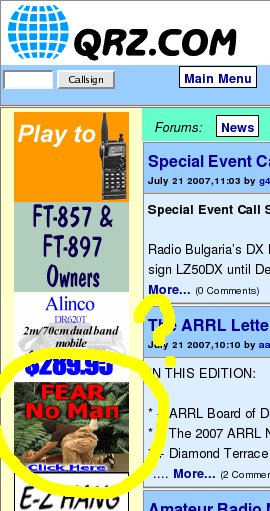Anyone (does anyone actually read it with regularity?) who reads this blog is familiar with my rant about the “decline of the fundamentals.” Here is a story about a recent antenna project and how trying to circumvent the fundamentals came back to bite me…
One of the perennial problems for hams on small city lots (and worse, rental property) is the installation of effective HF antenna systems. My current lot is about 170’x 100’…substantial for a city lot. But, it has a 1500-sq-ft duplex plus a two-car garage. There are streets on two sides and the (above-ground) power line comes in from the corner opposite the streets. There are four large trees ranging from about 40-70 feet tall, approximately forming a 70-ft square (yes, I know 80-meter 4-square).
I recently installed a 40-meter dipole between two of the trees and an inverted-L for 160 meters between another pair. These were decent antennas, all things considered. I worked EU on 160 and could actually hold a frequency on 40 in the CW SS. I’ve had two 80-meter antennas since we moved here. The first was a killer…a 40-ft top-loaded vertical with lots of radials where the garden is now. But, the landlady and Sarah asked me (nicely) to remove my radials from their garden. So, I hastily errected a zig-zag dipole about 20-25 ft up between three of the trees.
Needless to say, I’ve never been real happy with the dipole. Furthermore, I only got four radials down this Fall for the inverted-L and the extras I laid on the grass sorta looked like a rat’s nest. I got to thinking…I don’t operate 160 that much. I had a rope in the pine tree at almost 60 ft for the inverted-L and I’d successfully shot a line into the big tree in the back corner to install my 40-meter dipole. I shot another line into the tree from the roof of the house. Great! I can put an 80-meter dipole at 60 feet!
The neurons kept firing…if I feed it with open wire, I can short the feeder and run it as a top-loaded vertical on 160. Brilliant. I can put the matching unit on the roof and use elevated radials (I can’t believe I’m saying this…but, it’s the only option for this installation) on 160. Dad gave me a roll of #14 THHN for Christmas (raw materials make the best presents). I went to a big box hardware store and picked-up the remaining parts for $15. I started cutting PVC pipe for spreaders with a hacksaw in the basement…hard work! Then, I remembered that the CubeSat shop is in the lab next to my office. A minute and a half with the bandsaw did what I spent a half hour on the day before. And, they looked better to boot. I built the antenna and hauled it into the trees.
Of course, using open-wire line, I had to do some matching. I measured the input impedance after the 1:1 balun (built with type-31 ferrite using a K9YC recipe) with my Autek VA-1. It’s L-network time! I figured there’s got to be an L-network calculator on the Internet that will save me a few minutes’ work. Indeed there is. I punched in the numbers and hit [calculate]. The component values seemed reasonable; so, I built it. Finding a coil form was a bit of a challenge. I have some Miniductor stock; but, nothing big enough. I tried a lot of things that I’m too sheepish to mention here before one day as I was leaving the office…I saw my coil form…lots of them piled-up against the instrument cases and cardboard boxes: poster tubes from conference travel. For good luck, I selected the three-inch tube that got stuck in the baggage handling system at O’Hare on the way home from Spring AGU in Acapulco… Actually, it gave me great pleasure to carve that up with the bandsaw.
I built the coil, added some capacitance, and triumphantly returned the relay/matching unit to the roof. I hooked-up the VA-1…and it was awful. The impedance wasn’t even close (it’s like 20-j200) to 50 ohms. I started clipping capacitors in parallel and it got worse. Then, I cut some off (the original design had three in parallel) and it’s got worse again. I’m up a creek! I went inside and had lunch. After eating, I carefully checked every joint and wire…good. So, I calculated the expected transformation given the parts. Hmmm…it gave me what I measured. I looked at the online calculator more carefully…
The calculator took the parallel equivalent circuit for the load, not the series equivalent circuit! I was in disbelief…who uses the parallel equivalent circuit unless they’re doing a calculation?! Apparently, the author did. Of course, it makes sense in retrospect…if I was writing an L-network calculator, this is the logical way to do it. I computed the parallel equivalent circuit, recalculated, and rebuilt. It hit almost dead-on 50 ohms.
It’s easy to see the lesson here: pay attention to details. But, perhaps the more important lesson is that the existence of ready-made design software does not justify ignorance of the fundamentals. Had I calculated the L-network by hand, I would have made the series-to-parallel transformation myself (or even better, let the VA-1 do it for me…wait, isn’t that how I got here?) as a part of the process. To quote the country song (out of context, of course), this was “time well-wasted.” I have a story to tell my students some day!
